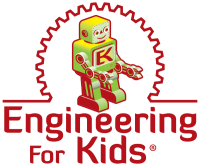Programs profiled: Junior Engineers, Apprentice Engineers and Master Engineers.
Website
Countr(ies)
145 locations in 21 countries – please see the website for specific information
Grade Level of Students Participating
Grades Pre-K to 8
Number of Students Participating per Year
150,000 worldwide since 2009
Year Organization Began
2009
Relationship to the public education system
Works as a franchise-based model outside of public education system. Offered through after-school classes, camps, workshops and birthday parties.
Organization’s Vision and Mission
“Our mission is to provide fun and educational engineering programs to children to inspire them to pursue engineering careers.”
“Our vision is for every child to discover what engineers do and explore what opportunities are available to them in STEM fields”
Brief Description of Program Activities
Programs categories are split into three levels according to grade level:
- Junior Engineers (Pre-K to 2nd grade).
- Apprentice Engineers (3rd to 5th Grade)
- Master Engineers (6th to 8th Grade).
Program topics include the following: Aerospace Engineering, Chemical Engineering, Civil Engineering, Electronic Game Design, Environmental Engineering, Marine Engineering, Hardware Engineering, Mechanical Engineering, Robotics Engineering, and Software Engineering.
Examples of Programs:
- “Fun Foundations” (Junior Civil Engineering for pre-K to 2nd grade students): Building a house to withstand the Big, Bad Wolf is where it begins in Junior Civil. This class is centered on exploring the concepts of building and construction through hands-on exploration and design. Students explore the engineering behind skyscrapers, bridges, roads, and more.
- “Go Green” (Apprentice Environmental Engineering for 3rd to 5th grade students): During the Environmental Engineering classes, students use the Engineering Design Process to design, create, test, and refine basic solutions related to alternative energy and environmental issues. They learn principles behind crafting efficient wind-powered machines and discover how those machines can be used to help reduce the use of fossil fuels. During the culminating project, students test different materials to discover which ones most effectively clean up after an oil spill.
- “Platform Games” (Apprentice Electronic Game Design for 3rd to 5th grade students): During Electronic Game Design: Platform Games, students will use Clickteam Fusion 2.5® to create their own video game. A platform game is a side-scrolling, Mario-type game where students program characters and a two-dimensional obstacle course. They attempt to avoid or overcome enemies and reach an end goal on multiple levels. At the end of the program, everyone takes home a working Windows-compatible game.
- “Envirobots” (Master Robotics Engineering for 6th to 8th grade students): During the LEGO® Rescue EnviroBots, students design and program robots to help accomplish environmentally friendly tasks. By creating robots that can transfer nuclear waste, mine raw minerals, and deliver food and goods more efficiently, they will learn how to contribute to a more sustainable environment.
Programs sessions may be divided as follows:
After-School Programs – 1 to 1.5 hour classes in 4 to 8 week sessions. Offered in Public Schools, Private Schools, or at the home of a Homeschool Parent at the
Preschool, Elementary, and Middle School Levels.
Evening Classes – 1 to 1.5 hours classes held at community centers in the evenings typically offered in 6-week sessions.
Camps – held 3 hours per day for 5 days held at community centers, public schools, private schools, preschools, or at other children’s camp locations. Each week consists of two 3-hour camps, one held in the morning and another in the afternoon. Afternoon session topics are different than the morning’s session. Students pay double the fee for both camps.
Program Content: Intrapersonal Competencies
Intellectual curiosity: seeing what piques their interest
Career orientation: relating things in daily life to what is going on the field of engineering.
Perseverance: learning that failure is not a bad thing in the engineering design process,
Program Content: Interpersonal Competencies
Collaboration, cooperation, teamwork, assertive communication: students work within groups and take on a variety of roles (facilitator, hardware engineer, etc.)
Leadership: Students take turns at taking on the role of leader of the team.
Program Content: Cognitive Competencies
Problem-solving, creative thinking, decision-making, planning: students are given a certain number of resources and they have to construct a project based on amount of supplies that they have.
Program Content: Attitudes and Values
Explore engineering as a career option; enjoy learning math and science. Understand the importance of planning, designing, testing and improving, including understanding that failure is a natural part of the process of learning and of engineering.
Program Content: Pedagogy/ Active Engagement of Students
Engineering for Kids invites children to have fun while they use their knowledge of engineering and science to design, create and improve solutions to engineering problems. Children are natural engineers and love building and taking things apart. Engineering For Kids' programs engage students in hands-on, real world engineering experiences.
Junior programs focus on exploration with free-play, guided projects and easy to understand lessons.
Apprentice programs are designed for students to be exposed to the Engineering Design Process, which means to design, build, test and improve. Activities are very hands-on with concrete goals in mind.
Teamwork is necessary in Master classes to achieve complex goals.
Source of Information
1All information for this summary come from the Engineering for Kids website, the Engineering for Kids Franchise Report and a phone interview with the VP of Operations in July 2016.
Prepared by
Ashim Shanker


